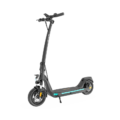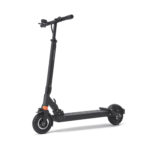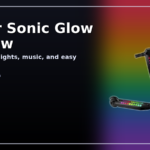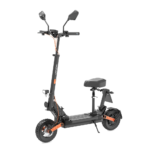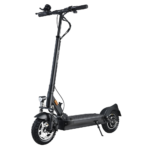- Home
- Scooters
- Electric Scooters
- JOYOR LiteGo
JOYOR LiteGo
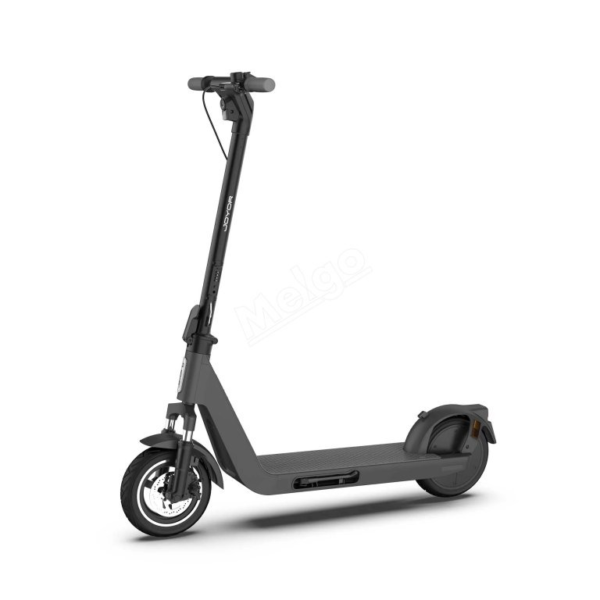

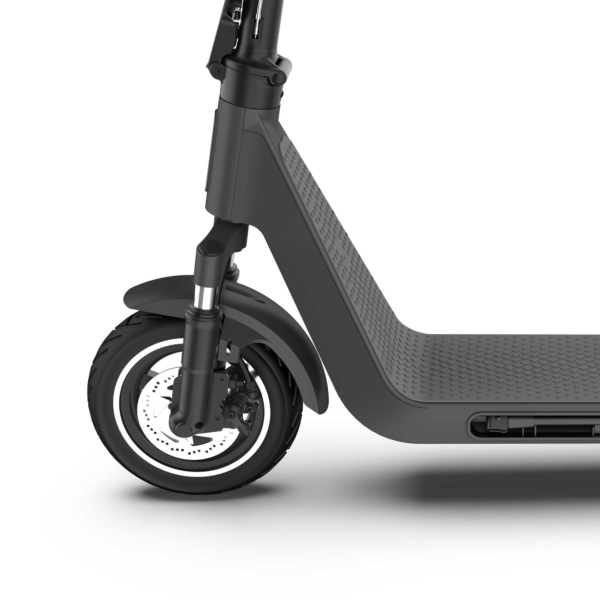
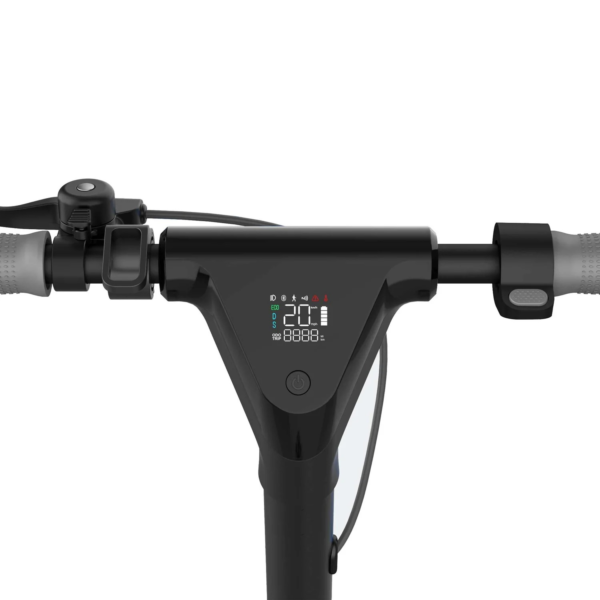
- Battery Range: Up to 45 km
- Top Speed: 25 km/h (DGT-limited)
- Motor Power: 350 W nominal
- Weight Capacity: 120 kg
- Charging Time: ~6.5 h
- Scooter Weight: 18 kg
PROS
- DGT certified for public roads in Spain
- IPX5 water resistance
- Dual-arm front suspension for comfort
- Integrated combination lock
- Light, compact, fast fold
CONS
- Front suspension only (no rear)
- 25 km/h speed cap by regulation
- Hill climb rated to 9°
- Air tires need pressure checks

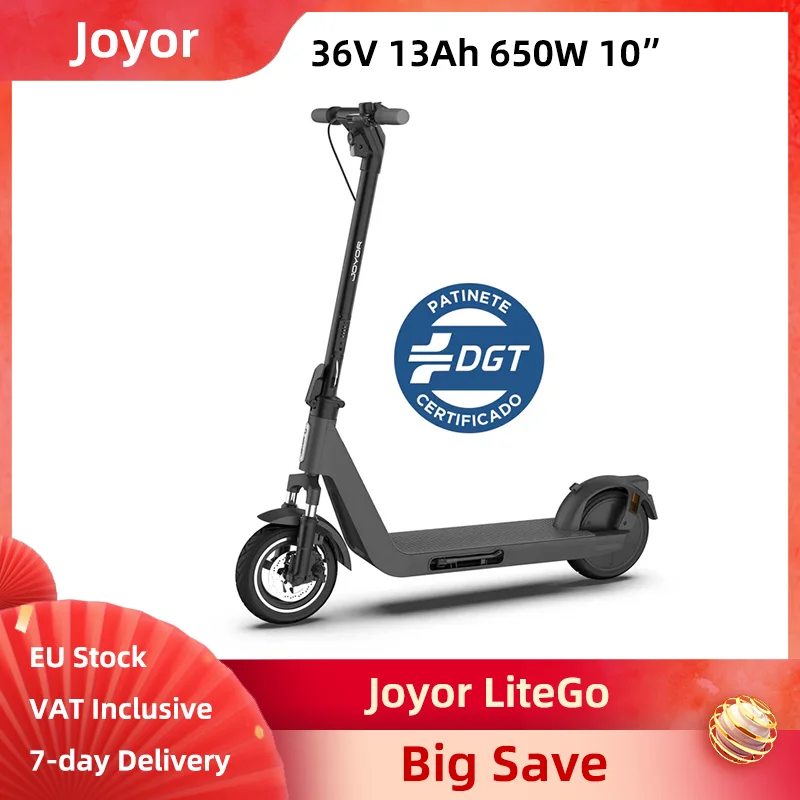
Table of contents
- What Is the JOYOR LiteGo?
- How the JOYOR LiteGo Works
- Key Specifications
- Design & Build Quality
- Performance Fundamentals
- Battery, Range & Efficiency
- Ride Quality & Comfort
- Braking & Safety Features
- Portability & Daily Usability
- Maintenance & Care
- Weather & Seasonal Considerations
- JOYOR LiteGo vs Alternatives
- Who the JOYOR LiteGo Is (and Isn’t) For
- FAQs
- Glossary
The JOYOR LiteGo is a city-friendly electric scooter built for dependable daily transport. It focuses on comfort, simple controls, and practical features like water resistance and an integrated lock. If you want a no-drama commuter that feels stable at cruise, the JOYOR LiteGo delivers a calm, confidence-building ride without the bulk or complexity of performance scooters.
What Is the JOYOR LiteGo?
The JOYOR LiteGo is a compact, IP-rated urban scooter with a 350W nominal hub motor (650W max), 10-inch pneumatic tires, and dual-arm front suspension. It is aimed at commuters, students, and multi-modal riders who need a scooter that folds quickly, tucks into tight spaces, and shrugs off light rain. Because it prioritizes stable handling and predictable braking over headline speed, it suits riders who want a smooth, low-stress way to cover the last few miles of their day.
How the JOYOR LiteGo Works
Electric scooters all share the same core building blocks. The JOYOR LiteGo keeps each of them straightforward.
- Motor: A rear-hub electric motor does the pushing. Think of it like a compact, sealed wheel with copper windings. When current flows, it spins the wheel directly—no chains or belts. Because the motor is in the wheel itself, maintenance stays light.
- Controller: The controller is the scooter’s “brain.” It meters battery power to the motor based on how far you twist or press the throttle. On the LiteGo, it also enforces speed modes, manages thermal protection, and coordinates electronic braking.
- Battery: A 36V, 13Ah lithium-ion pack stores energy for your ride. Voltage (V) defines how “hard” the system can push; amp-hours (Ah) indicate how much energy it can store. Together, they translate to practical range.
- Throttle: The thumb throttle tells the controller how much assist you want. Because the LiteGo provides multiple ride modes, you can cap speed and response for busy paths or open them up for wider boulevards.
- Brakes: Up front you get a mechanical disc brake for immediate, familiar stopping power. At the rear, an electronic E-ABS system helps scrub speed smoothly. The two together give you progressive, predictable control.
This simple package favors reliability. There’s no complex drivetrain, and the electronics are self-contained, so the scooter feels less fussy day to day.
Key Specifications
| Block | Item | Value |
|---|---|---|
| General | Model | JOYOR LiteGo |
| Intended Use | Urban commuting / daily transport | |
| Max Speed | 25 km/h | |
| Rider Height (recommended) | 120–200 cm | |
| Max Load | 120 kg | |
| Operating Temperature | −10°C to 40°C | |
| Water Resistance | IPX5 | |
| Certification | DGT (Spain) | |
| Performance & Power | Nominal / Max Motor Power | 350 W / 650 W |
| Drive | Rear-hub motor | |
| Speed Modes | 3 (Eco ~15 km/h, Standard ~20 km/h, Sport ~25 km/h) | |
| Claimed Hill Ability | 9° | |
| Battery, Charging & Electrical | Battery | 36 V 13 Ah (≈ 468 Wh, calculated) |
| Charger | 42 V, 2 A | |
| Charging Time | ~6.5 hours | |
| Electronics | LCD display, E-ABS rear brake | |
| Lighting | Front and rear lights; reflectors | |
| Build & Dimensions | Frame | Aluminum alloy |
| Tires | 10″ pneumatic (front & rear) | |
| Suspension | Dual-arm front | |
| Net Weight | 18 kg | |
| Unfolded Size | 1130 × 516 × 1210 mm | |
| Folded Size | 1130 × 516 × 570 mm | |
| Safety & Control | Brakes | Front mechanical disc + rear E-ABS |
| Visibility | Bright headlight, tail/brake light, side reflectors | |
| IP Rating | IPX5 (light-rain capable) | |
| Features & Extras | On-board Display | Multifunction LCD with ride modes & push mode |
| Lock | Integrated combination lock with chain | |
| Kickstand / Bell | Yes / Yes | |
| Cruise Control | Not specified by the manufacturer | |
| Bluetooth | Optional (varies by unit) | |
| Warranty & Compliance | Warranty (Electrical Parts) | 24 months (36 months in Spain) |
| Battery Warranty | 12 months or 2000 km (whichever comes first) | |
| Compliance | EU / DGT (market-specific) |
Design & Build Quality
The JOYOR LiteGo favors clean lines and practical durability. The aluminum frame keeps weight moderate while resisting corrosion. Because the deck is wide with a grippy surface, you can stand naturally with your feet slightly offset. That stance matters during longer rides; it lets knees flex to absorb bumps while keeping your shoulders relaxed.
The stem locks with a conventional hinge and hook system. It folds flat and stays tidy, which helps on trains or under a desk. At cruise, the stem feels secure, and minor flex—common on commuter stems—stays in the background. The handlebar layout is simple: throttle on one side, brake lever on the other, and the LCD centered for glanceable speed and battery readings.
Fit-and-finish is solid for the class. Cables route cleanly, the headlight sits high enough to throw useful beam, and the rear light is easily visible to traffic. The integrated lock, tucked along the stem, is a thoughtful touch. It will not replace a heavy-duty U-lock in high-risk areas, but it covers quick stops and discourages casual tampering.
Performance Fundamentals
From a standstill, the JOYOR LiteGo eases into motion rather than lunging. In Eco and Standard modes, throttle response is gentle; you can roll away without upsetting your balance or surprising nearby pedestrians. Sport mode adds enough snap for merging into lighter traffic or climbing mild grades, yet it never feels nervous.
At neighborhood speeds, straight-line stability is a strong point. The 10-inch pneumatic tires track cleanly, and the front suspension takes the sting out of expansion joints and brick sections. Because the deck is roomy, weight shifts are easy. You can load the front wheel a bit through turns for confidence without inducing wobble.
On 7–10% grades, expect steady, measured climbing. The motor sustains pace better in Sport mode, although speed will taper on longer hills, especially for heavier riders. Starts on short inclines are workable; the controller feeds in power smoothly, which helps you keep balance when you push off. The listed 9° climb ability suggests urban slopes are within its design envelope, provided you plan speed and mode accordingly.
Battery, Range & Efficiency
The 36V, 13Ah pack is well-matched to the LiteGo’s powertrain. In efficient city riding, range can approach the rated figure when a lighter rider cruises in Eco or Standard mode on flat paths in mild temperatures. However, real-world range varies. Rider weight, headwinds, frequent stops, rough surfaces, and cold weather all increase energy use.
To stretch range consistently:
- Ride in Eco for bike paths and shared spaces; switch to Standard for mixed streets.
- Keep speeds even. Because aerodynamic drag rises quickly, shaving a few km/h extends distance.
- Accelerate progressively. Hard launches draw large current bursts that warm the motor and waste energy.
- Keep tires at the recommended 45–50 psi. Under-inflation increases rolling resistance and can invite pinch flats.
- In winter, start with a warm pack, then ride. Cold cells deliver less energy; you’ll see more voltage sag and earlier cut-offs.
For charging, budget a typical overnight window (~6.5 hours) from low to full. Although the battery management system protects the pack, adopting good habits helps longevity: avoid storing at 100% for days, and avoid running to 0% repeatedly. A comfortable routine is charging to full shortly before you ride, or leaving the scooter around 40–70% if it will sit for several days.
Ride Quality & Comfort
Comfort comes from three places: tires, suspension, and ergonomics. The 10-inch pneumatic tires are the star, rolling over cracks and grit that stall smaller, solid tires. They create a natural “air spring,” so small chatter turns into a muted hiss rather than a rattle.
Up front, the dual-arm suspension adds a second layer of smoothing. It is tuned on the firmer side, which preserves steering feel; you won’t get the wallow sometimes found on soft spring forks. Instead, the front end stays composed at cruising pace and resists topping out when you hop curbs at walking speed.
Ergonomically, the cockpit is uncluttered. The thumb throttle has a light, linear feel, so setting a steady pace is easy. The brake lever engages after a short, consistent throw, which helps you modulate stops with one finger. During longer commutes, the wide deck lets you change foot positions, reducing hotspots and helping knees and hips stay relaxed.
Stem flex exists on most folding designs. On the LiteGo, it remains subtle within its speed limits. If you press hard on the bar over rough patches, you may feel a small amount of give; it does not build into wobble when the scooter is maintained and the headset is properly tightened.
Braking & Safety Features
Braking components are simple and effective. The front mechanical disc provides the main stopping force. It has a firm initial bite about halfway through the lever pull, and it tightens predictably as you squeeze harder. The rear E-ABS helps trim speed smoothly and can reduce tire lockups on slick surfaces.
Lighting is better than basic. The front lamp sits high, projecting a modest beam that improves path visibility after dark. The rear lamp brightens under braking, and side reflectors add passive visibility at intersections. Because the scooter carries an IPX5 rating, you can ride through light rain. Nevertheless, braking distances grow on wet pavement, and standing water can hide potholes; ride slower and avoid painted stripes.
Finally, a bell helps alert others on shared paths. Use it early and keep your line predictable; courtesy reduces conflict more than loud horns or sudden swerves.
Portability & Daily Usability
At 18 kg, the JOYOR LiteGo is carryable for short flights of stairs and quick transfers, though frequent long climbs will still feel heavy. The folding mechanism is intuitive: lower the stem, secure the hook, and grab the stem near the clamp as the carry point. Because the folded footprint stays 1130 × 516 × 570 mm, it slides along a wall at home or office.
For storage, keep it indoors when possible. Lithium batteries prefer stable temperatures, and aluminum hardware ages better away from salt and moisture. If you must park outside, the integrated combination lock is convenient for short stops. For higher-risk areas, pair it with a heavier lock through a fixed anchor. Remove quick-grab items and avoid leaving the scooter unattended for long stretches.
Day to day, the three ride modes let you tune behavior to the space. Eco mode makes sidewalks and crowded paths less stressful, while Standard covers most city errands. Sport mode is there for merging traffic and short hills. Because the display is simple and bright, you can confirm speed and battery at a glance and keep your eyes up.
Maintenance & Care
A light, regular routine keeps the JOYOR LiteGo riding like new:
- Every ride: Quick look at tire tread and pressure (aim for 45–50 psi). Squeeze the brake lever; listen for scraping that suggests pad rub. Check the latch is fully engaged after unfolding.
- Weekly: Wipe dust from the deck and wheels. Inspect the brake caliper and rotor for debris. Check the headset area for play—hold the front brake and rock the scooter; tighten if you feel knocking.
- Monthly: Check fasteners on the stem clamp, axle nuts, and brake hardware. A quarter-turn can prevent rattles. Clean and dry the charging port cap. Review the tires for embedded glass or cuts.
- Battery care: Avoid heat and deep discharges. If you store the scooter a week or longer, leave the battery around half full. Top up before rides instead of leaving it at 100% for days.
- Software/app: If your unit includes Bluetooth, check for firmware updates and follow any official guidance on displays or controllers. Update only when the scooter is fully charged and stationary.
If braking feels spongey, align the caliper and check cable tension. If you hear pad rub, center the caliper and spin the wheel to confirm clearance. For persistent noises after rain, dry the rotor with a clean cloth and perform a few gentle stops to re-bed the pads.
Weather & Seasonal Considerations
Rain: IPX5 helps with light rain, but traction still drops. Reduce speed, brake earlier, and avoid metal grates and painted lines. After wet rides, wipe the scooter dry, especially around the folding joint and brake components.
Cold: Lithium chemistry delivers less energy when cold. Expect reduced range, slower acceleration, and earlier low-voltage cut-offs. Store and charge indoors; start riding with a warm battery for best results.
Heat: High ambient temperatures increase battery and controller temperatures. Park in shade and avoid prolonged full-throttle sprints. If the scooter reduces power to protect itself, ease off and let it cool.
Dust & debris: The pneumatic tires tolerate grit well, yet glass and construction sites raise puncture risk. Consider puncture-resistant inner tubes if flats become frequent, and keep pressure on spec.
JOYOR LiteGo vs Alternatives
Versus entry-level “last-mile” scooters: The JOYOR LiteGo rides more comfortably thanks to larger pneumatic tires and front suspension. It also feels more stable at cruise and stops more confidently with its front disc. You do carry a bit more weight than ultra-light models.
Versus commuter class with similar motors: The LiteGo leans into comfort and simplicity. Some rivals add rear suspension or larger batteries; they also tend to weigh more. If your route includes lots of stairs or multi-modal transfers, the LiteGo’s balance of weight and ride quality is appealing.
Versus performance scooters: High-power scooters accelerate harder and climb faster, but they are heavier, pricier, and often overkill for bike lanes. If you need a step up in power and suspension travel for rougher routes, consider the JOYOR S10-S-Z as a performance-class alternative; it trades some portability for stronger acceleration, higher cruising stability, and more braking headroom.
Versus off-road-oriented models: Knobby tires and long-travel suspension help on trails, yet they add rolling resistance and imprecision on pavement. The LiteGo, with its street-centric setup, stays efficient and planted on asphalt and pavers.
Who the JOYOR LiteGo Is (and Isn’t) For
Great for:
- Riders who value comfort and predictability over raw speed.
- Students and commuters who want a scooter that folds cleanly and fits in small storage spaces.
- Multi-modal travelers who combine scooters with trains, buses, or carpools.
- Newer riders who want gentle throttle response, clear feedback, and easy braking.
Think twice if:
- You routinely climb long, steep hills and need brisk uphill pace.
- You want hydraulic dual-disc brakes and high-speed stability at 35–40 km/h.
- You prefer ultra-light scooters under 13 kg for frequent carrying.
In short, the JOYOR LiteGo suits riders who want a calm, comfortable commuter with honest city manners and straightforward care.
FAQs
1) How far can the JOYOR LiteGo go on a charge?
Under efficient city riding with a lighter rider and mild weather, range can approach the rated figure. Hills, cold, heavy loads, and stop-and-go traffic reduce distance.
2) Can I ride the JOYOR LiteGo in the rain?
Yes, its IPX5 rating supports light-rain use. However, braking distances increase on wet roads, so slow down and avoid standing water.
3) What tire pressure should I use?
Aim for 45–50 psi. Proper inflation preserves range, handling, and puncture resistance.
4) Does the JOYOR LiteGo have cruise control?
Cruise control is not specified by the manufacturer. Use the three ride modes to manage speed instead.
5) What maintenance does it need?
Check tire pressure before rides, keep the brake adjusted, and tighten key fasteners monthly. Store the battery at moderate charge if the scooter sits.
6) Is there an official JOYOR LiteGo overview I can consult?
The manufacturer provides a product page and user manual where the JOYOR LiteGo overview and technical details are published.
7) How does it handle hills?
On typical 7–10% city grades, expect steady but measured climbing, especially in Sport mode. Plan momentum and keep throttle smooth to maintain pace.
Glossary
- Ah (Amp-hour): A measure of how much charge a battery can store. Higher Ah often means more range.
- Wh (Watt-hour): Energy capacity (V × Ah). Indicates potential range more directly than Ah alone.
- Controller: The electronic module that meters power from the battery to the motor and enforces limits.
- Hub Motor: A motor built into the wheel hub; direct drive without belts or chains.
- E-ABS: Electronic braking assistance that helps control wheel speed and smooth deceleration.
- Regen (Regenerative Braking): Using the motor as a generator to slow the scooter and recover a little energy. (Degree of regen varies by model.)
- Stem Flex: Slight bending in the folding stem under load; normal in many commuter scooters.
- IP Rating: Ingress Protection scale; IPX5 means resistant to low-pressure water jets.
- Voltage (V): Electrical “pressure”; higher voltage can deliver more power at a given current.
- Current (A): Flow of electric charge; more current means more torque but higher heat.
- PSI: Pounds per square inch; a measure of tire pressure.
- Ride Modes: Preset limits on speed and acceleration to suit different environments.
- Thermal Throttling: Automatic power reduction to protect electronics from heat.
- Deck: The standing platform of the scooter.
- BMS: Battery Management System; protects the pack from over-charge, over-discharge, and short circuits.
Specifications
General
| Model The Model specifies the exact version or name of the scooter. It helps identify its unique design, features, and specifications within the manufacturer’s product line. Knowing the model makes it easier to compare options, find compatible accessories, or look up support information. | LiteGo |
| Brand The Brand identifies the manufacturer or company that designs and produces the scooter. A trusted brand is a sign of quality, reliability, and good customer support. Well-known brands often have higher standards for safety, performance, and after-sales service, giving you more confidence in your purchase. | JOYOR |
| Release Date The Release Date indicates when the scooter model was officially launched on the market. This helps you know how current the design, technology, and features are. A newer release date often means updated components, improved performance, and the latest safety or smart features. | 17 November 2025 |
| Recommended Age Recommended Age indicates the minimum age range that the scooter is designed for, based on safety, size, and ease of use. Following the recommended age helps ensure that riders can handle the scooter’s speed, weight, and controls comfortably and safely. Always check local laws and use protective gear, especially for younger riders. | Recommended 14+ |
Performance & Power
| Motor Power (Wattage) What it means: The motor power, measured in watts (W), shows how strong the scooter’s electric motor is. Why it matters: Higher wattage usually means better acceleration, more torque, and improved performance on hills or rough terrain. For example, a 250W motor is good for flat city roads and light riders, while a 500W or 1000W motor provides more power for faster speeds or climbing steep inclines. | 350 W nominal (650 W max) |
| Top Speed The Top Speed indicates the maximum speed that the scooter can reach under optimal conditions. It’s usually measured on level ground with a fully charged battery and an average rider weight. A higher top speed allows you to travel longer distances faster, but always ensure you ride within legal speed limits and your personal comfort zone for safety. | 25 km/h (DGT-limited) |
| Battery Capacity Battery Capacity refers to the total amount of energy the scooter’s battery can store, usually measured in ampere-hours (Ah) or watt-hours (Wh). A higher battery capacity means you can ride longer distances on a single charge, reducing the need for frequent recharging. Keep in mind that actual range can vary depending on rider weight, terrain, speed, and weather conditions. | 36 V 13 Ah |
| Estimated Range per Charge The Estimated Range per Charge indicates the average distance the scooter can travel on a single full battery charge. This range is calculated under optimal conditions, such as flat terrain, moderate speed, and average rider weight. Real-world range may vary depending on riding style, terrain, weather, and load. A longer range means fewer recharges and greater freedom for longer trips. | Up to 45 km |
| Hill Climb Ability Hill Climb Ability describes the maximum incline or slope that the scooter can handle while maintaining stable performance. It’s typically expressed as a percentage or in degrees. A higher hill climb rating means the scooter can tackle steeper hills without losing too much speed or power. Actual climbing performance may vary based on rider weight, battery charge, and terrain conditions. | Up to 9° grades |
| Drive System The Drive System refers to how power from the motor is delivered to the wheels. Electric scooters typically use either a hub motor (directly integrated into the wheel) or a chain/belt drive system. A high-quality drive system ensures smooth acceleration, efficient power transfer, and low maintenance. The choice of drive system affects performance, noise level, and overall ride experience. | Rear hub motor (RWD) |
Charging & Electrical
| Charging Time Charging Time indicates how long it takes to fully recharge the scooter’s battery from empty to 100% using the standard charger provided. Faster charging means less downtime and more time on the road. Actual charging time may vary slightly depending on battery capacity, charger output, and environmental conditions. | Approx. 6.5 hours |
| Battery Type Battery Type refers to the specific technology used in the scooter’s battery, which affects performance, lifespan, weight, and charging time. Most modern electric scooters use high-quality lithium-ion (Li-ion) batteries because they offer a good balance of energy density, durability, and low maintenance. A reliable battery type ensures consistent power delivery and longer riding ranges. | Lithium-ion pack |
| Removable Battery A Removable Battery means the battery pack can be easily detached from the scooter for convenient charging and replacement. This feature allows you to charge the battery separately, swap it with a spare for extended range, or securely store it indoors in extreme weather. Removable batteries add flexibility and make it easier to keep your scooter powered up wherever you are. | Non-removable internal battery (fixed pack) |
| Regenerative Braking Regenerative Braking is an energy-saving feature that converts some of the energy normally lost during braking back into battery power. When you slow down or brake, the motor works in reverse to generate electricity, which helps extend the scooter’s range and improves overall efficiency. This system also reduces wear on traditional brake components, leading to lower maintenance over time. | Yes |
| Lighting Lighting refers to the built-in front and rear lights that enhance visibility and safety when riding in low-light conditions or at night. Good lighting helps you see the road ahead and ensures that other road users can see you. Many scooters include LED headlights, taillights, and sometimes brake lights or side reflectors for added safety and compliance with local traffic regulations. | Headlight + tail/brake + side reflectors |
Build & Dimensions
| Scooter Weight Scooter Weight refers to the total weight of the scooter when fully assembled, including the battery. This affects how easy it is to carry, lift, and store the scooter when not in use. A lighter scooter is more portable and convenient for commuting, especially if you need to carry it upstairs or onto public transport. Keep in mind that a sturdy frame and quality components may add to the weight but also contribute to better durability and ride stability. | 18 kg |
| Maximum Rider Weight Maximum Rider Weight indicates the highest rider weight that the scooter is designed to safely support while maintaining optimal performance and stability. Staying within this limit helps ensure reliable acceleration, braking, and climbing ability, and it protects the frame, suspension, and motor from excessive strain. Exceeding the recommended limit may reduce performance and increase wear on components. | 120 kg |
| Deck Size Deck Size refers to the dimensions of the scooter’s standing platform. A wider and longer deck provides more foot space, allowing you to stand comfortably and adjust your stance while riding. A well-sized deck improves balance and stability, especially on longer rides or at higher speeds. Compact decks, on the other hand, help keep the scooter lightweight and portable. | Low deck; wide standing area |
| Handlebar Height Handlebar Height refers to the distance from the deck to the handlebars, which affects your riding posture and comfort. An appropriate handlebar height helps you maintain good balance, reduces strain on your back and arms, and makes steering more comfortable. Some scooters have adjustable handlebars to fit riders of different heights, while others have a fixed height for a streamlined design. | Adult fixed bar height |
| Folding Mechanism The Folding Mechanism describes how easily and securely the scooter can be folded for carrying and storage. A well-designed folding system lets you quickly collapse the scooter into a compact size, making it convenient to transport on public transit, store under a desk, or fit into a car trunk. Look for sturdy latches and safety locks to ensure the scooter stays firmly in place when folded or unfolded. | Quick folding latch |
| Dimensions Folded Dimensions indicate the size of the scooter when it’s fully folded. This measurement shows how much space the scooter will take up when stored or carried, making it easier to check if it will fit in your car trunk, under a desk, or in a closet. Compact folded dimensions are ideal for commuters who need to bring their scooter on public transport or store it in tight spaces. | 1130 × 516 × 570 mm (folded) |
| Material Material refers to the primary construction materials used for the scooter’s frame and key components. High-quality materials like aircraft-grade aluminum, reinforced steel, or durable composites provide strength, stability, and a lighter overall weight. A sturdy material ensures the scooter can handle daily wear and tear while maintaining safety and performance. | Aluminum alloy frame |
Safety & Control
| Brake Type(s) Brake Type(s) describe the braking systems the scooter uses to help you slow down or stop safely. Common brake types include mechanical brakes (like drum or disc brakes), electronic brakes, and foot brakes. Many scooters combine multiple braking systems for added safety and shorter stopping distances. The type and quality of brakes affect your control, especially when riding at higher speeds or on slopes. | Front disc + rear E-ABS |
| Suspension Suspension refers to the system that absorbs shocks and vibrations while riding, providing a smoother and more comfortable ride over uneven or rough surfaces. Scooters may have front suspension, rear suspension, or dual suspension for better shock absorption and stability. Good suspension helps reduce rider fatigue and improves control, especially when riding on bumpy roads or off-road paths. | Dual-arm front suspension |
| Tire Type Tire Type refers to the kind of tires the scooter uses, which directly affects ride comfort, traction, and maintenance. Common types include solid (airless) tires, pneumatic (air-filled) tires, or hybrid options. Pneumatic tires offer better shock absorption and a smoother ride on rough surfaces, while solid tires are puncture-proof and require less upkeep. The right tire type helps ensure safe handling and a comfortable ride in different conditions. | Pneumatic street (air) |
| Tire Size Tire Size indicates the diameter and width of the scooter’s tires, which affect ride comfort, stability, and how well the scooter handles different terrains. Larger tires generally offer better shock absorption and a smoother ride over bumps and rough surfaces, while smaller tires keep the scooter lighter and more portable. Choosing the right tire size helps ensure a balance between agility and comfort. | 10-inch |
| Kickstand The Kickstand is a built-in stand that allows you to park your scooter upright when it’s not in use. A sturdy kickstand keeps the scooter stable and prevents it from tipping over, protecting it from scratches and damage. It also makes storing and accessing your scooter more convenient, whether you’re at home, work, or on the go. | Side kickstand |
| Water Resistance Rating Water Resistance Rating indicates how well the scooter is protected against water and moisture, usually shown as an IP (Ingress Protection) rating. This rating helps you understand whether the scooter can handle light rain, splashes, or wet roads without damage. While most scooters are not fully waterproof, a good water resistance rating adds peace of mind when riding in changing weather conditions. Always avoid deep puddles or submerging the scooter to protect its electrical components. | IPX5 body |
Features & Extras
| Display/Console The Display (or Console) shows important real-time information about your ride, helping you monitor your scooter’s status at a glance. Typical displays show speed, battery level, distance traveled, and riding mode. Some models also include additional features like Bluetooth connectivity, app integration, or backlighting for better visibility at night. A clear and easy-to-read display enhances safety and convenience on every trip. | Multifunction LCD dashboard |
| Ride Modes Ride Modes refer to the different speed and power settings you can choose to match your riding style or road conditions. Common modes include eco for maximum range and energy efficiency, standard for everyday balance, and sport or turbo for higher speed and stronger acceleration. Switching between ride modes allows you to customize performance, conserve battery, and ride safely in various environments. | Eco (15 km/h), Standard (20 km/h), Sport (25 km/h) |
| Smart App Connectivity Smart App Connectivity lets you pair your scooter with a dedicated mobile app via Bluetooth. Using the app, you can monitor real-time ride stats like speed, battery level, and range, adjust settings such as ride modes or cruise control, lock the scooter for added security, and sometimes receive firmware updates. This feature adds convenience and allows you to personalize your riding experience right from your smartphone. | App-free basic operation |
| Anti-Theft System The Anti-Theft System helps protect your scooter from unauthorized use or theft. This feature can include built-in alarms, electronic motor locks, GPS tracking, or remote locking through a mobile app. A good anti-theft system provides peace of mind when parking your scooter in public spaces, adding an extra layer of security to safeguard your investment. | Integrated combination lock |
| Cruise Control Cruise Control allows you to maintain a steady speed without continuously holding the throttle. This feature makes longer rides more comfortable by reducing hand fatigue and providing a smoother, more relaxed riding experience — especially on flat, open roads or bike lanes. For safety, cruise control can usually be easily activated or deactivated while riding. | Yes (cruise control) |
| Accessories Included Accessories Included lists the additional items that come with the scooter to enhance your riding experience and convenience. Common accessories may include a charger, kickstand, bell, lights, phone holder, or carrying strap. These extras add value by making your scooter safer, easier to use, and ready to ride straight out of the box. | Bell, reflectors, charger |
Warranty & Compliance
| Warranty Period The Warranty Period indicates how long the manufacturer guarantees the scooter against defects in materials and workmanship under normal use. A good warranty provides peace of mind, showing the brand’s confidence in its product quality. Always check what parts are covered, such as the frame, battery, and motor, and follow the maintenance guidelines to keep your warranty valid. | 24 months on electrical parts; 12 months/2000 km battery (36 months in Spain) |
| Certifications Certifications confirm that the scooter meets specific safety, quality, and environmental standards set by recognized organizations or regulatory bodies. Common certifications may include CE, RoHS, UL, or other local compliance marks, depending on your region. These certifications ensure that the scooter is manufactured to high standards and is safe and legal to use in your country. | DGT certification for public roads in Spain |
Price Comparison




